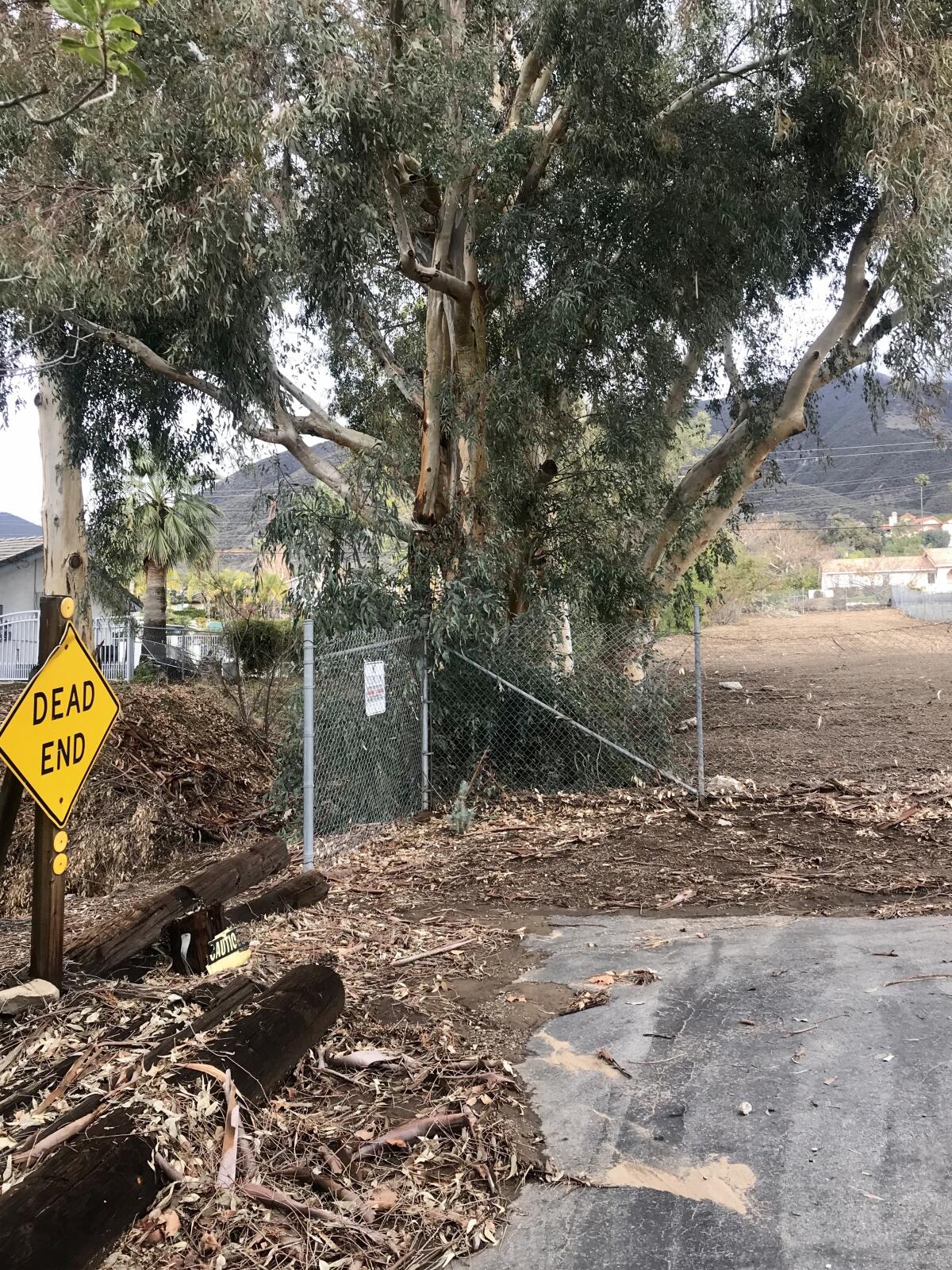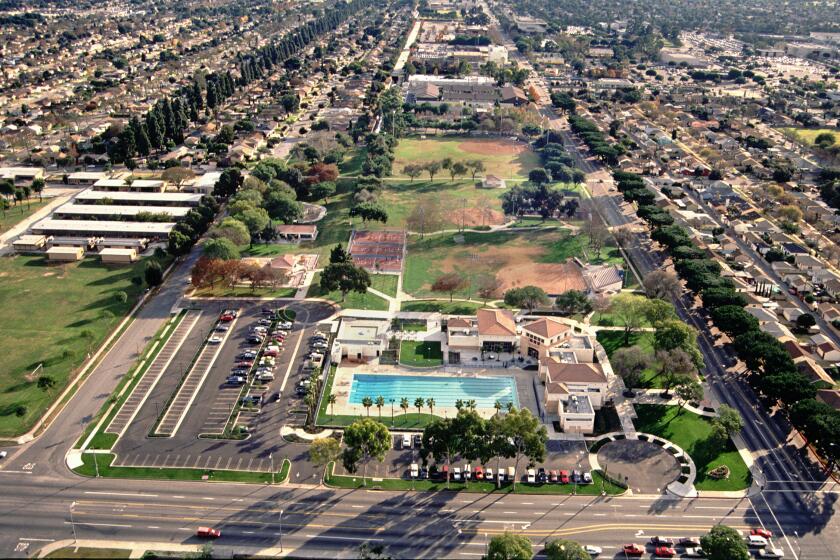Op-Ed: My people aren’t Joan Didion’s true Californians, and I have felt this so keenly

- Share via
It could have been coincidence, or normal atmospheric conditions, that in the three weeks before Joan Didion’s death she was on my mind. The blustering Santa Ana winds she imbued with dread had littered the streets of Riverside with fallen palm fronds like thousands of lion tails.
In late November, I made an impetuous pilgrimage to a place Didion made famous in “Some Dreamers of the Golden Dream,” a place where my own roots run deep, because her essays formed me as a writer from the time I was 17 until even last week, from her prose to her derision to her elision of the kind of people I love here. Even my ability to make a lyrical, rhythmic sentence comes from studying her essays and fiction for decades, as countless writers said last week.
With sentences like “a kind of people who imagined they might live among the talismanic fruit and prosper in the dry air” she cut us to the quick. She was a tiny badass — her sunglasses and cigarettes, her Stingray and freeways, her refusal to be anything less than a prescient storyteller.
Where Didion saw dread and doom in suburban Los Angeles, writer D.J. Waldie saw the positive intersection of place and personality .
The wind started at midnight on Nov. 24, the birthday of my younger brother, who died in 2002. On that day in 1963, when my mother was in the hospital giving birth to him, powerful Santa Anas blew open the door to her tiny one-bedroom house in Glen Avon, on Donna Way, near the Pomona Freeway. Tumbleweeds had once piled up against our door so high we couldn’t push it open. I was 3. My father had left us, fallen in love with a beautiful divorcée with four children in Ontario.
Both my mother and Didion were born in December 1934. Didion was fifth-generation California; my mother arrived in Fontana as an immigrant from Switzerland, 19 years old, to join her father and stepmother, who had gotten jobs at Kaiser Steel and lived in a trailer park. Diminutive women with different eyes.
I collected maybe 50 fronds into a pile at my curb, missing my brother hard, and then sat on the porch the Friday morning after the wind rereading “Some Dreamers” from the 1968 paperback “Slouching Towards Bethlehem,” with the neon orange cover. The first time I read it was in 1978 as a freshman at USC. In journalism class, we were handed this Xeroxed essay painting a place soaked in noir, dread and betrayal:
“This is the California where it is possible to live and die without ever eating an artichoke, without ever meeting a Catholic or a Jew. This is the California where it is easy to Dial-A-Devotion, but hard to buy a book … the country of the teased hair and the Capris and the girls for whom all life’s promise comes down to a waltz-length white wedding dress and the birth of a Kimberly or a Sherry or a Debbi and a Tijuana divorce and a return to hairdressers’ school. ‘We were just crazy kids,’ they say without regret, and look to the future. The future always looks good in the golden land, because no one remembers the past.”
I was stunned, but, of course, only well-honed sharpness can sting. The alliteration, the intricate elegance, the absolute classism that I felt in my chest but didn’t fully understand for years.
Now I can see the very particular details: artichoke? My stepmother, who had grown up in Texas poverty and thought of Ontario as the promised land, was the first person who served me canned artichokes. Clearly, waltz-length was not as good as floor-length, though why a waltz? The parents I knew danced to Etta James and Patsy Cline. Never meeting a Catholic? Fully a third of my childhood classmates were Chicano, several generations descended from Mexico, and the essay took place near Guasti, where San Secondo d’Asti had been built in the 1920s by Italian immigrants who worked the immense vineyards. Another third of my schoolmates were Black, including my future husband, whose mother, sisters, grandmother and great aunt all had lived in Riverside since 1936.
A week after the Santa Anas, I drove my oldest daughter, Gaila, to the Ontario airport for her flight back to Texas. Our three daughters had come home to help their dad, who’d fallen ill. Instead of going home, I drove up Vineyard Avenue until it bent into Carnelian Avenue, one focal point of Didion’s chronicle of the case of Lucille Miller in “Some Dreamers” — the young wife convicted of killing her husband, Gordon, by burning him alive in their 1964 Volkswagen, having pushed it into a lemon grove on Banyan Street.
Of this scene, Didion wrote: “Like so much of this country, Banyan suggests something curious and unnatural. The lemon groves are sunken … so that one looks directly into their dense foliage, too lush, unsettlingly glossy, the greenery of nightmare; the fallen eucalyptus bark is too dusty, a place for snakes to breed.”
Banyan Street is now lined with miles of two-story homes, most of the men pulling into their driveways Latino, while I drove into the past, turning onto Sapphire Street, searching Google Maps for the house where Lucille Miller had lived: 8488 Bella Vista. I finally found a sign: “Private Road.” In the fast-falling dark, I cruised slowly to the bright yellow “Dead End” sign at a rough gash cut by rainfall. A vacant acre of earth surrounded by chain-link. No trace of the dream.
The day of Didion’s death, I read again “Where I Was From,” published in 2003. Clear themes emerged: dresses of organdy and drapes of organza, marriages that dissolved, the destruction of love that mirrored the decay of the landscape, the land Didion’s people believed to be the true California, the one belonging to sons and daughters of pioneers, of families like hers that arrived on wagon trains and were fortunate enough to split off from the Donner Party.
My mother turned 87 on Monday. She has severe memory loss, but she loves to drive into the past, where she can remember vividly the places Didion made famous, though the only thing she ever knew of Didion was the day I brought home “Some Dreamers” from college and told her about Lucille Miller. “Your Aunt Beverly lived across the street from that woman once,” my mother said in 1978 while wiping our Formica counter. “She always said that woman would kill someone.”
Banyan Street was considered part of Cucamonga then. My mother worked at a bank in San Bernardino, seven miles away. My father had settled with his new family seven miles the other way from Banyan, in Claremont, and my aunt Beverly lived in Ontario with her third husband and my three cousins.
I write this because my people are not Didion’s people, and I have felt this so keenly. For many Californian writers, Didion’s work brings both admiration and ambivalence, flint and steel to sharpen and etch our own Californias. In my California are women like my mother and aunt and my friends, we Kimberlys and Sherrys and Debbis. Black and Latina and Asian American, our dreamers so often first generation or new arrivals to California.
I never met Joan Didion. These last decades, I tried to imagine her in New York. No one could drive a Stingray across four lanes of freeway there or go to Ralphs in a bikini. (The day before Didion’s death, my mother called six times. I took her to Ralphs, where we bought Kleenex, Chapstick and Toblerone, as we do every few days. My mother, with an utter lack of sentiment, survived the life described in “Some Dreamers.”)
I didn’t take the freeway home that night from Carnelian Avenue because our Southern California is filled with great expanses of warehouses and thousands of trucks moving slowly as their own holiday light parade. The back roads took me to Mission Boulevard, past the Rubidoux Drive-In where I had just been to the swap meet to buy glittery baby Converse shoes for the newborn daughter of my neighbors Mario and Nancy Soria, whose parents came from Michoacán.
But I detoured to my mom’s first tiny house on Donna Way, between Pyrite and Agate. The streets around Glen Avon were named for girls and gemstones. Donna Way was built in 1960, along with other small lanes nearby — Sherry Lane, Christine Avenue and Joan Avenue. I understand the lyrical power of listing these names because of Joan Didion. I drove the seven miles home, not knowing she was fading — but of course, we dreamers never truly disappear.
Susan Straight’s new novel, “Mecca,” will be released in March.
More to Read
A cure for the common opinion
Get thought-provoking perspectives with our weekly newsletter.
You may occasionally receive promotional content from the Los Angeles Times.











